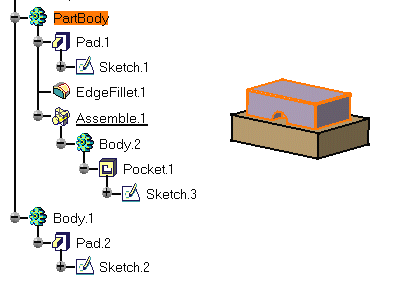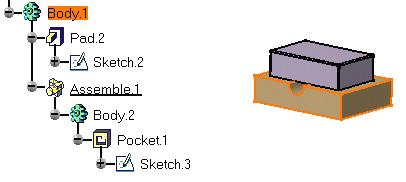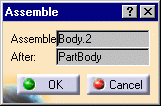Assembling Bodies
| Assembling is an operation integrating your part specifications. It allows you to create complex geometry. This task shows you two assemble operations. You will see then how the resulting parts look different depending on your specifications. | ||||
| When working in a CATProduct document, it is not necessary to copy and paste the bodies belonging to distinct parts before associating them. You can directly associate these bodies using the same steps as described in this task. | ||||
| Open the Assemble1.CATPart document and make sure Part Body is the current body. | ||||
| First, you are going to assemble a pocket on Part Body. You will note that as this pocket is the first feature of the body, material has been added (see Pocket). | ||||
| 1. | To assemble them, select Body 2 and click the Assemble...icon
|
|||
|
Assembling a set of bodies (multi-selected via the Ctrl key) is possible. This capability will increase your productivity. |
||||
 |
||||
| The Assemble dialog box displays to let you determine the operation you wish to perform. By default, CATIA proposes to assemble the selected body to Part Body. | ||||
|
|
||||
| 2. | Click OK to confirm. During the operation, CATIA removes the material defined by the pocket from Part Body. This is your new Part Body: |
|||
 |
||||
| 3. | Now delete the assemble operation to go back to the previous state. You are going to perform the second assemble operation. | |||
| 4. | Select Body.2 and the Edit -> Body2.object ->
The Assemble dialog box displays again. |
|||
| 5. | Select Body.1 in the specification tree to edit the After: field. Pad.2 appears in the field, indicating that you are going to assemble Body.2 on Body.1. | |||
| 6. | Click OK. The material defined by the pocket from Body1 has been removed during the operation. |
|||
 |
||||
|
||||
|
||||
Structuring Your Design |
||||
|
Generally speaking, using Boolean Operations is a good way of structuring your part. Prior to designing, you can actually define the part's structure by associating a body containing geometry with empty bodies. Once these specifications are done, you can then concentrate on the geometry. |
||||
|
|
||||
